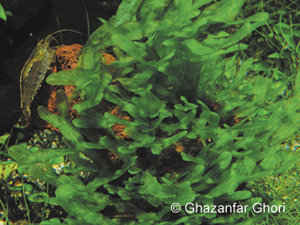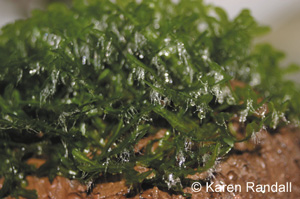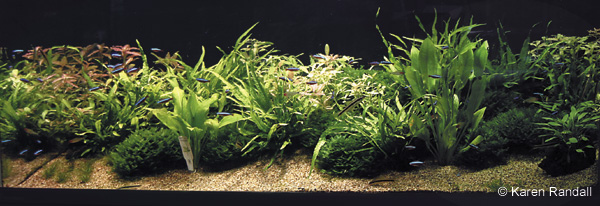
For some time Tropica has been selling a plant known as Pellia,
which has now been renamed Monosolenium tenerum. When plant names change,
it usually means that botanists have discovered that they are not in fact dealing
with the plant they thought they were, or, more seldom, that two botanists have
independently discovered and named the same plant. In the latter situation,
the first name to be announced is always the one that applies. Spelling errors
are a different matter, and may be repeated so many times that the correct spelling
is only discovered when someone refers to the original description. In the present
case, several factors have contributed, and there are spelling mistakes in both
the old and the new name.
Monosolenium tenerum has been mistakenly known as Pellia or
Pelia (with a single l
) and the erroneous specific name has
also been spelt in two different ways as endiviifolia and endiviaefolia.
In addition, Monosolenium has been seen spelled with an e
instead of the third o
on occasions. In other words there has been
a good deal of confusion, and unfortunately the matter was not entirely settled
when Tropica had the plant labels printed. There will therefore be a transitional
period in which plant labels will be seen with the third o
wrongly
transformed into an e
! However, we hope that the correct name, Monosolenium
tenerum, will eventually become established among growers as well as aquarium
owners. The subject of erroneous names is an amusing study in its own right—read
the full story in the German magazine Aqua-Planta no. 3 - 2003.
Monosolenium tenerum is extremely rare in the wild, only found in small
colonies in India, China, Taiwan, Japan and possibly Thailand. Monosolenium
tenerum is a sort of aquatic parallel to the Gingko biloba (maidenhair tree),
an ancient living fossil
among plants, rarely seen in the wild,
but which has become very popular in cultivation.

Monosolenium tenerum is a liverwort and does not technically have leaves. The green part of the plant, which resembles leaves, is known among botanists as the thallus (plural thalli), and this thallus divides into fork-like branches, giving a cushion-formed growth. Monosolenium tenerum looks very much like Riccia magnified ten times. Riccia is well known for floating on the surface. To flourish on the bottom, Riccia requires extremely favorable growth conditions and must be anchored with fishing line or a hairnet to the bottom.
Monosolenium tenerum is much easier to grow! It is heavier than water and therefore remains on the bottom. It only makes modest demands on the aquarium environment. Once it has begun to flourish it spreads generously and forms attractive cushions on the bottom of the aquarium. However, the plant is quite brittle and falls apart easily during transport, so transplanting it initially into the aquarium may not be easy. To give it the best possible start it can be attached with nylon line to a stone, or small sprays can be scattered between other plants such as Eleocharis, which will prevent it from being carried about in the aquarium by fish or water circulation.
When Monosolenium tenerum begins to thrive in the aquarium, it develops a green leaf-like structure almost 1 cm wide, which forks every 1 - 1.5 cm. The thallus is an attractive, slightly translucent olive green and flourishes in a wide temperature range, from 5°C to 30°C (40.9°F to 85.9°F). It grows in shade or full sunlight and is tolerant of hard or soft water. If Monosolenium tenerum is grown under less favorable conditions, it develops a longer leaf structure (2 - 3 cm), which is narrower (3 - 5 mm) and less decorative.

On the underside of the leaf structure, attachment filaments form as very fine, threadlike growths known as rhizoids. Rhizoids can anchor the plant to stones or tree roots, but this attachment is not particularly effective under water. Even if it is not attached to the bottom, the plant forms rhizoids, which can be seen under water as a diffuse veil on the underside of the thalli. Under ideal conditions in an aquarium with plenty of light and CO2, many tiny oxygen bubbles will form and catch in the rhizoids. These may cause parts of the plant to break away from the bottom and rise to the surface.
Monosolenium tenerum can be grown in a moist terrarium or in small plastic boxes on the windowsill, provided it is not too hot. It has not yet been found under water in the wild, but it is probably only a matter of time before evidence of underwater growth will be found. Monosolenium tenerum is apparently not eaten by fish, but the fish can swim around in the plant and thus spread it around the aquarium! It can be used as a foreground plant or arranged sloping upwards in large cushion formations in the background. If you can imagine it, you can do it!

Its number at Tropica is 002C, and it is available as portions or attached to ceramic stones in three sizes.